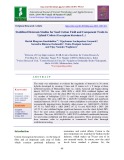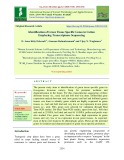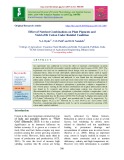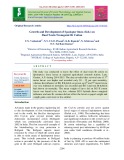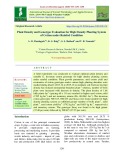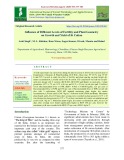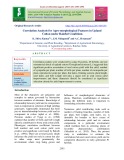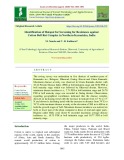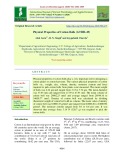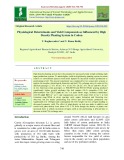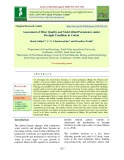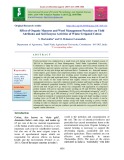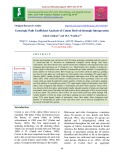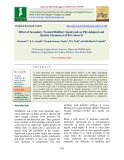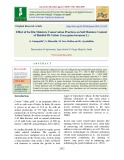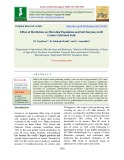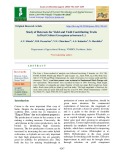
Cotton bolls
-
The study was undertaken to evaluate the magnitude of heterosis in 36 cotton hybrids developed by crossing 3 lines and 12 testers in L x T design at three different locations of Maharashtra State viz., Akola, Amravati and Nagpur during kharif, 2017-18. The cross AKH 8828 x AKH 9916 exhibited highest and significant heterosis over the check PKV Hy-2 for seed cotton yield/plant (60.30 %), number of bolls/plant (23.55 %) and fibre strength (10.43 %) across the environments.
 15p
15p  chauchaungayxua12
chauchaungayxua12
 29-07-2021
29-07-2021
 9
9
 1
1
 Download
Download
-
The present study aims at identification of green tissue specific genes in Gossypium hirsutum variety, Suraj for promoter isolation and characterization in the future. For this, transcriptome sequencing of three different tissues viz., seed, leaf and boll rind was done. Differential gene expression analysis between seed (non green) and leaf and bollrind (green) tissues was done to identify genes which are highly expressed in green tissues i.e., leaf and boll rind and very low or no expression in non green tissues i.e., seed.
 8p
8p  chauchaungayxua10
chauchaungayxua10
 18-03-2021
18-03-2021
 11
11
 1
1
 Download
Download
-
The research work comprising of genetic variability, heritability and genetic advance as well as correlation and path analysis study for 12 quantitative traits in three genotypes of cotton (Gossypium arboreum L.) was carried out during 2015 and 2016 at Research Farm of Cotton Section, Department of Genetics and Plant Breeding, CCS Haryana Agricultural University, Hisar, India. The genotypic differences were significant for all the traits except number of monopods/plant and number of seeds/boll.
 8p
8p  cothumenhmong9
cothumenhmong9
 18-01-2021
18-01-2021
 19
19
 1
1
 Download
Download
-
An experiment was conducted to reveal the effect of nutrients combinations on plant pigments and yield in Bt cotton under rainfed condition in kharif season of 2011-2012. The experiment was laid out in randomized block design with ten treatments (T1 to T10) replicated thrice. Data on total chlorophyll, anthocyanin and dry matter yield at square formation, boll development, boll bursting and harvest stage whereas the seed cotton yield at harvest stage was collected and analysed.
 6p
6p  cothumenhmong9
cothumenhmong9
 18-01-2021
18-01-2021
 10
10
 2
2
 Download
Download
-
The study was conducted to know the effect of dual toxin Bt cotton on Spodoptera litura larvae at regional agricultural research station, Lam, Guntur, A.P. during 2014-2015.
 11p
11p  gaocaolon9
gaocaolon9
 22-12-2020
22-12-2020
 19
19
 2
2
 Download
Download
-
A field experiment was conducted to evaluate optimum plant density and suitable G. hirsutum cotton genotype for high density planting system under rainfed condition. Plant growth parameters, seed cotton yield and economics of cotton genotypes under various high planting densities were studied during kharif, 2013-14 to 2015-16 on medium soil. Increase in plant density has reduced monopodial branches plant-1 whereas, number of bolls plant were increased with increase in density.
 8p
8p  trinhthamhodang1216
trinhthamhodang1216
 19-11-2020
19-11-2020
 16
16
 2
2
 Download
Download
-
Maximum yield is achieved at optimum plant density which depends upon environmental condition, cropping system and cultivar (Bridge et al., 1973; El-Shinnawy and Ghaly, 1985; Halemani and Hallikeri, 2002). However, farmers are adopting various plant geometries with wider row spacings as well as closer plant spacings. As Bt cotton cultivation has resulted in early setting of bolls, ultimately it requires more nutrients. The present study was carried out to know the effect of spacing and fertility levels growth and yield of Bt cotton.
 7p
7p  trinhthamhodang1216
trinhthamhodang1216
 19-11-2020
19-11-2020
 11
11
 2
2
 Download
Download
-
Correlation studies were conducted by using 10 parents, 45 hybrids and one commercial check of upland cotton (Gossypium hirsutum L.) suggested that significant positive association of seed cotton yield with lint yield, number of sympodia per plant, number of bolls per plant, number of monopodia per plant, reproductive point per plant, lint index, Ginning outturn, plant height, seed index and boll weight will play a major role in seed cotton yield improvement and these characters should be considered as significant selection criteria for yield improvement in cotton.
 4p
4p  cothumenhmong7
cothumenhmong7
 09-09-2020
09-09-2020
 17
17
 1
1
 Download
Download
-
The study brought at first time the influence of geographical coordinates with severity of boll rot complex.
 7p
7p  nguaconbaynhay7
nguaconbaynhay7
 15-08-2020
15-08-2020
 6
6
 1
1
 Download
Download
-
Physical properties of cotton bolls play a very important role in designing a cotton picker or cotton harvester. The various physical properties of cotton bolls viz., weight, size, volume, density, moisture content and force required to pick cotton bolls from plants were measured.
 6p
6p  nguaconbaynhay7
nguaconbaynhay7
 15-08-2020
15-08-2020
 13
13
 1
1
 Download
Download
-
High density planting system have the potential for increased yields in high yielding, high input production systems. To attain higher yields in high density planting system in cotton relative to conventional spaced cotton must depend on increased biomass production or partitioning to boll.
 7p
7p  angicungduoc6
angicungduoc6
 22-07-2020
22-07-2020
 10
10
 1
1
 Download
Download
-
To investigate the water-deficit tolerance, 3 cotton genotypes (Bunny Bt, Pratima and Anjali.) were grown under normal irrigation and water-deficit conditions. Moisture is a key factor affecting growth and yield of Cotton in which stress is the most important factor limiting crop productivity due to adverse effect on fruit production, square/boll shedding and lint yield as well as fiber quality properties of Cotton. If water supply is limited during boll development it could result in significantly lower yields. In this study stress imposed with four watering treatments viz.
 8p
8p  angicungduoc6
angicungduoc6
 22-07-2020
22-07-2020
 17
17
 1
1
 Download
Download
-
Field experiment was conducted on a sandy loam soil during winter irrigated season of 2015-16 at Department of Farm Management, Tamil Nadu Agricultural University, Coimbatore to study the effect of various organic manures and weed control methods on yield attributes and soil enzyme activities of organic cotton cultivation. The experiment was laid out in strip plot design and replicated thrice. Treatments viz.
 9p
9p  chauchaungayxua6
chauchaungayxua6
 26-06-2020
26-06-2020
 17
17
 2
2
 Download
Download
-
Present investigation was carried out with 38 cotton genotypes including both the species G. arboreum and G. hirsutum in randomized complete block design with three replications. The observations were reported form three randomly selected plant from each treatment and replication on 17 characters viz., Plant height (cm), number of nodes per plant, length of internodes (cm), number of monopodia per plant, number of sympodia per plant, number of bolls per plant.
 7p
7p  nguaconbaynhay6
nguaconbaynhay6
 24-06-2020
24-06-2020
 11
11
 0
0
 Download
Download
-
A field experiment was conducted during Kharif season of 2014-15 to evaluate the Effect of High Density Planting System (HDPS) and Genotypes on growth parameters and Yield contributing traits in upland cotton at Cotton Research Unit, Dr. P.D.K.V., Akola. The experiment was laid out in FRBD design consisting of four factors of plant densities viz., 45 x 10, 60 x10, 75 x 10 and 60 x 15 cm2 in main plots and three factors of cotton varieties i.e., AKH-081, NH-615 and Suraj in sub plots with replicated thrice.
 7p
7p  quenchua6
quenchua6
 15-06-2020
15-06-2020
 24
24
 1
1
 Download
Download
-
A field experiment was conducted during Kharif 2010-11 at the Main Agricultural Research Station, University of Agricultural Sciences, Dharwad to study the response of secondary treated distillery spentwash on physiological and quality parameters of Bt cotton under rainfed condition. Result indicated that application of 1.5 N through distillery spentwash significantly increased the total dry matter production (339.7 g plant-1 ), leaf area (51.3 dm2 plant-1 ), LAI (0.95), good opened bolls plant-1 (31.2) and yield (2566.1 kg ha-1 ), but was on par with 1 N through spentwash.
 6p
6p  quenchua6
quenchua6
 15-06-2020
15-06-2020
 22
22
 2
2
 Download
Download
-
A field experiment conducted on clay soil of Regional Agricultural Research Station, Lam, Guntur, during kharif 2017-18.
 7p
7p  angicungduoc5
angicungduoc5
 12-06-2020
12-06-2020
 10
10
 0
0
 Download
Download
-
India is the largest cotton producing country, covers an area of approximately 36 % area representing about 11.3 million hectares under cotton. It also consumes considerable amount of herbicides and pesticides which are biologically active compounds which may lead to the significant changes in the soil microorganisms. Hence, in this study the herbicides viz., pyrithiobac, pendimethalin and pyrithiobac + quizalofop are sprayed as pre-emergence herbicides and the soil samples were collected at squaring, flowering, boll formation and at harvesting stage.
 16p
16p  kethamoi5
kethamoi5
 03-06-2020
03-06-2020
 8
8
 0
0
 Download
Download
-
The Line x Tester method of analysis was followed involving 5 females viz., PA 740, PA760, PA848, PA828 and PAIG 77 and 6 males viz., AKA 9703, JLA 505, RAC 024, AKA 7, PA 08 and Phule Dhanwantary for study of heterosis for various yield and fibre characters. The F1’s and their parents were evaluated in Randomized Block Design with two replications. Observations were recorded on Days to 50% flowering, Plant height (cm), Number of sympodia per plant, Number of bolls per plant, Boll weight (g), Seed index, Seed cotton yield per plant (g) and Lint index.
 9p
9p  trinhthamhodang1213
trinhthamhodang1213
 29-05-2020
29-05-2020
 12
12
 0
0
 Download
Download
-
Cotton is one of the most important fiber and cash crop of India and plays a dominant role in the industrial and agricultural economy of the country. Sixty crosses with thirteen parents and three checks viz., PKV-Hy-4, NHH-206 and NHH- 44 were grown in Randomized Block Design with two replications. The results showed that the tester AKH07R possessed the highest GCA effect for the seed cotton yield per hectare and also exhibited high GCA (in desirable direction) for the traits, number of sympodia, number of bolls per, harvest index and cotton seed yield per plant.
 10p
10p  trinhthamhodang1213
trinhthamhodang1213
 29-05-2020
29-05-2020
 6
6
 0
0
 Download
Download
CHỦ ĐỀ BẠN MUỐN TÌM









